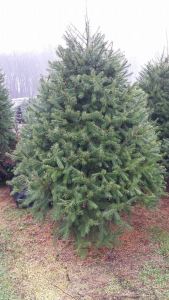 Fall is full swing and as the air slowly starts to dip into the cooler temperatures, the thoughts of Christmas start to float into the atmosphere. Stores all over the area are already stocked with Christmas goodies and decorations, and crazy enough, some of the Christmas sales have already started. With the thoughts of Christmas and sales, come the age-old debate for a lot of families, real or artificial tree this year? Both options have their appeal. For some, an artificial tree is more cost-effective, but for others that smell of a real Christmas tree and the symbolism it represents just can’t be beat. We are obviously in the pro real tree category, but not just because we grow real trees.
Fall is full swing and as the air slowly starts to dip into the cooler temperatures, the thoughts of Christmas start to float into the atmosphere. Stores all over the area are already stocked with Christmas goodies and decorations, and crazy enough, some of the Christmas sales have already started. With the thoughts of Christmas and sales, come the age-old debate for a lot of families, real or artificial tree this year? Both options have their appeal. For some, an artificial tree is more cost-effective, but for others that smell of a real Christmas tree and the symbolism it represents just can’t be beat. We are obviously in the pro real tree category, but not just because we grow real trees.
According to a study performed by an environmental consulting firm in Montreal, an artificial tree has to be reused for at least 20 years to be greener than purchasing a real tree annually. The average family only uses their artificial tree for 6-10 years.
The study goes further to point out some other key points about real trees.
Real trees are renewable: When a tree is cut down, another tree can be grown to replace it. For every Christmas tree harvested, 1 to 3 seedlings are planted the following spring.
Real trees are recyclable: After the season, Christmas trees can be used for birdhouses, mulch, and fuel chips. Have a look at all the recycling options and tips from the National Christmas Tree Association. Artificial trees are made from non-biodegradable plastic, meaning they can’t be recycled. After those 6-10 years of use, most sit in a landfill for centuries. There are more than 4,000 recycling programs in the United States.
Real trees support life: Trees absorb carbon dioxide as well as other gases, and emit oxygen. Most fake trees contain polyvinyl chloride which produces carcinogens that can cause liver cancer or developmental problems during manufacturing and disposal. The PVC can also be a potential source of hazardous lead. While real Christmas trees filter smog and dust from the air.
Real trees preserve green space: Often times, Christmas trees are grown on soil that can’t support other crops, utilizing space that would otherwise serve no purpose. Learn about the National Christmas Associations Project Evergreen.
Real trees provide shelter: Real Christmas trees provide a comfortable habitat for a variety of wildlife.
There are close to 350 million Christmas trees growing in the United States alone, while 80 percent of artificial trees are manufactured in China. The United States real Christmas tree industry employees over 100,000 people.
We hope you’ll join us at Clark’s this year to get a real tree. Real Christmas trees help the environment and the economy.
Information courtesy of Marsha Gray and MCTA
Sources: National Christmas Tree Association, NY Times, CNN Money, Smithsonian

